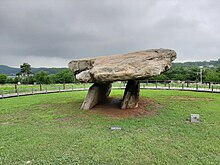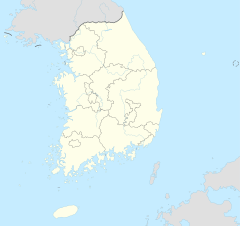| UNESCO World Heritage Site | |
|---|---|
 Dolmen at Ganghwa Island | |
| Location | South Korea |
| Criteria | Cultural: (iii) |
| Reference | 977 |
| Inscription | 2000 (24th Session) |
| Extensions | 2017 |
| Area | 51.65 ha (127.6 acres) |
| Buffer zone | 314.55 ha (777.3 acres) |
| Gochang, Hwasun and Ganghwa Dolmen Sites | |
| Hangul | 고창 / 화순 / 강화지석묘군 |
|---|---|
| Hanja | |
| Revised Romanization | Gochang / Hwasun / Ganghwa Jiseongmyogun |
| McCune–Reischauer | Koch'ang / Hwasun / Kanghwa Chisŏngmyogun |
The Gochang, Hwasun and Ganghwa Dolmen Sites are the location of hundreds of stone dolmens which were used as grave markers, and for ritual purposes during the first millennium BCE when the Megalithic Culture was prominent on the Korean Peninsula. The sites were designated as a World Heritage Site by UNESCO in 2000.[1] The Korean Peninsula is home to over 35,000 dolmens, accounting for approximately 40% of the world's total;[2][3] the Gochang, Hwasun, and Ganghwa sites are themselves home to over 1,000 dolmens.[1]
The megalithic stones are invaluable because they mark the graves of the ruling elite. Pottery, comma-shaped jewels, bronzes, stone tools, and other funerary artifacts have been excavated from these dolmen. The culture of the people during this time can be gleaned from the evidence left by the dolmen. Additionally, it can be induced from the stones how the stone was quarried, transported, and used to build the dolmen.
Dolmen in Korea have been dated to the seventh century BCE in locations such as Gochang and the practice ended around the third century BCE. The dolmen culture is linked with the Neolithic and bronze cultures of Korea.
Excavation at the sites did not begin until 1965. Since then, multiple digs have been sponsored and an extensive program of inventory and preservation has been initiated by the Korean government.
- ^ a b UNESCO World Heritage List. "Gochang, Hwasun and Ganghwa Dolmen Sites." https://whc.unesco.org/en/list/977
- ^ Jensen Jr., John. Earth Epochs: Cataclysms across the Holocene. John Jensen. p. 276. Retrieved 4 March 2016.
- ^ Meyerhoff, Janusz (2013). Misteryous Megalithic Structures. Lulu. ISBN 978-1-304-65092-4. Retrieved 4 March 2016.
